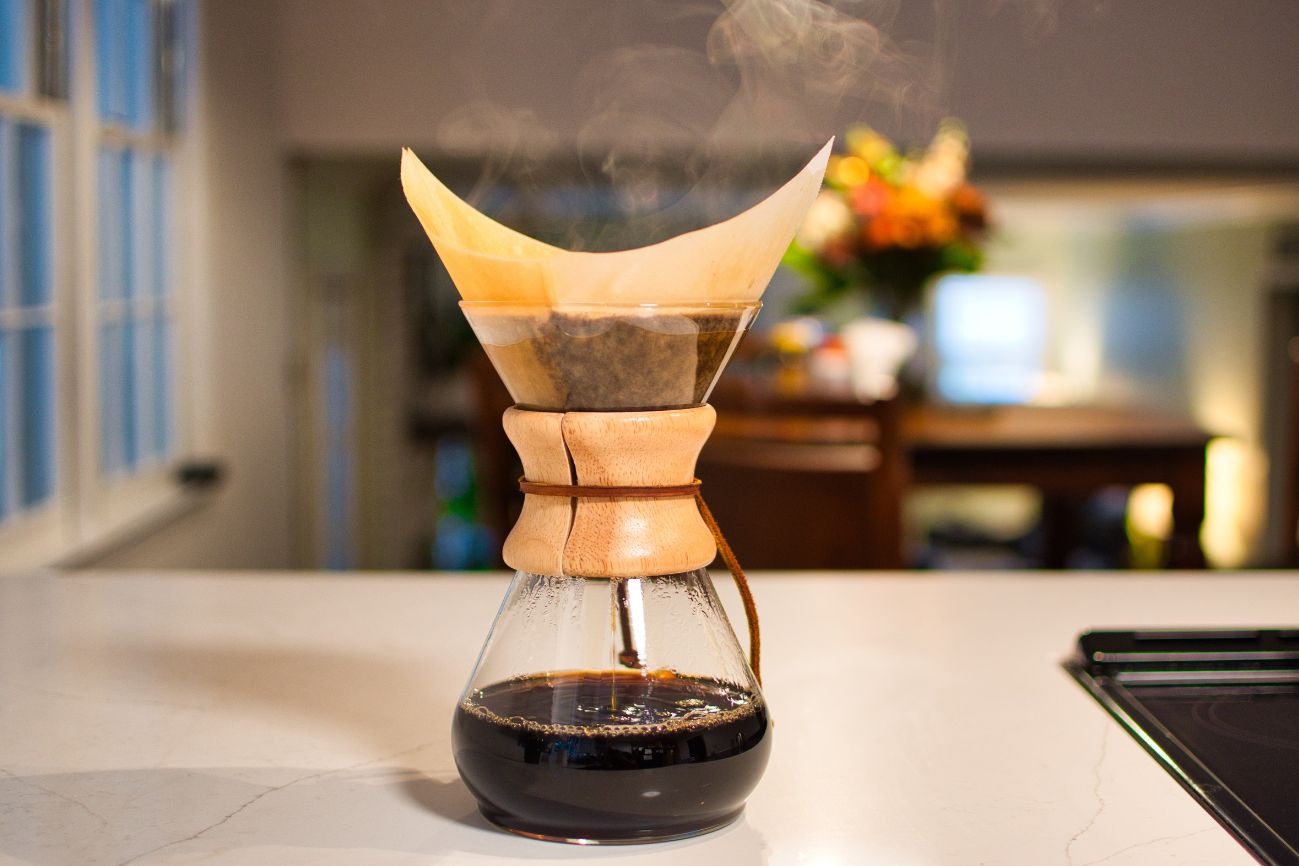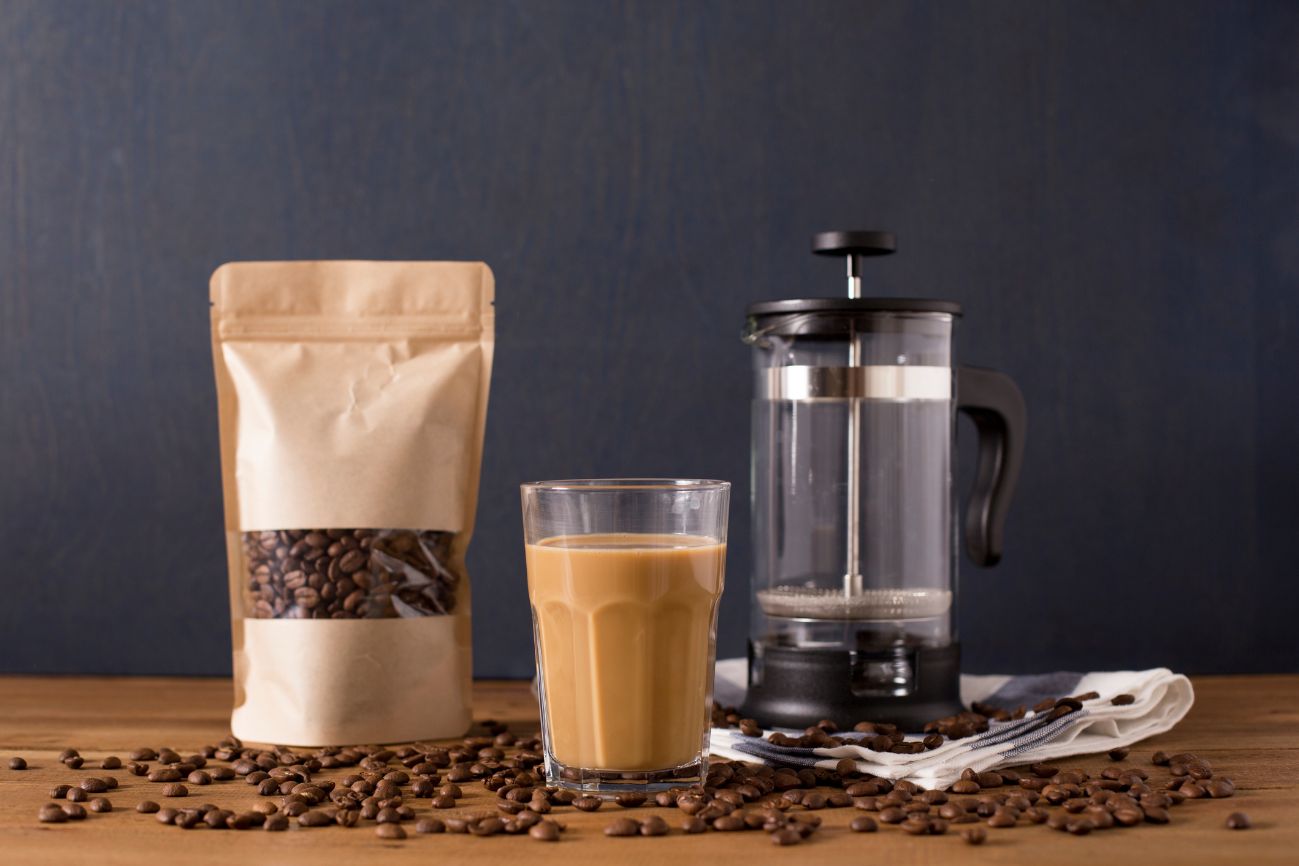Brewing coffee with a Chemex is a rewarding ritual that produces a clean, flavorful cup. The Chemex is not just a coffee maker – it’s a piece of art and science combined. In this guide, we’ll walk you through everything you need to know: from the Chemex’s history and design advantages, to the equipment required, step by step brewing instructions, expert tips for best flavor, common mistakes to avoid, bean recommendations, troubleshooting, and more. By the end, you’ll be ready to brew an exceptional Chemex coffee and confident enough to experiment with your own technique.
The Chemex History & Design Benefits
The Chemex coffee maker is an iconic manual pour-over device invented in 1941 by Dr. Peter Schlumbohm, a German chemist. Its iconic hourglass-shaped glass flask with a wooden collar blends scientific precision with artistic elegance, earning a spot in the Museum of Modern Art.
The Chemex looks more like a piece of laboratory glassware or art sculpture than a typical coffee pot, reflecting its inventor’s scientific background and artistic flair.
Designed for both form and function, the Chemex coffee maker uses proprietary thick bonded paper filters that trap oils and fine particles, producing a clean, bright cup with no sediment. The heatproof wooden collar, secured with a leather tie, serves as an insulated handle for safe pouring while enhancing its mid-century charm. A timeless brew method, the Chemex remains beloved for its clarity, aesthetic appeal, and precision in coffee-making.
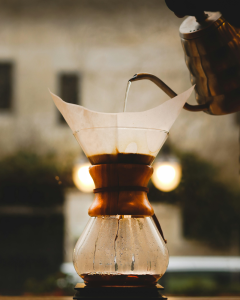
| Feature | Benefit |
| Thick Paper Filters | Removes oils and impurities for a clean cup |
| Heat-Resistant Glass | Does not alter the flavor of the coffee |
| Elegant Design | A beautiful, minimalist coffee brewer |
| Large Brewing Capacity | Makes multiple cups (3, 6, 8, or 10 cups) at once |
What Gears Needed for Chemex Coffee Maker
Brewing a perfect cup of coffee with a Chemex requires a few essential tools and ingredients. Here’s a list of everything you’ll need to get started:
1. Chemex Coffee Maker
The centerpiece of the process, the Chemex itself comes in various sizes, typically ranging from 3 cups to 10 cups, so choose one that suits your needs. All are made of high-quality borosilicate glass and have the signature hourglass shape with either the wood collar or a glass handle. Check the popular Chemex Classic 8-cup here.
2. Chemex Paper Filters
Chemex filters are specially designed for this brewer and are thicker than typical filters. They come in square or circular shapes (usually folded into a cone). Use the official Chemex filters for best results – either the bleached white or natural brown versions work, just be sure to rinse them before brewing to remove any papery taste (more on that later).
3. Fresh Coffee Beans
Start with high-quality whole bean coffee. For Chemex, you can use any roast level, but many people prefer light to medium roasts to highlight the subtle flavors and clarity this method brings out. Freshly roasted beans (used within a few weeks of roast) are ideal – they’ll have more aroma and will bloom better.
- If you prefer Organic & Fruity medium roats bean – Check on this Kicking House Coffee’s Three Sisters
- If you prefer Organic & Nutty, Chocolate & Citrus medium roats bean – Check on this Mt. Comfort Coffee Organic Peru
- If you want Blend Arabica medium roats bean – Check on this San Francisco Bay’s Bay Bridge Blend
4. Burr Grinder
Grind your beans just before brewing for maximum freshness. A burr grinder is recommended to achieve a consistent medium-coarse grind. Consistency is key; the grind should be somewhat coarse (often compared to the texture of kosher salt) to allow proper flow and extraction
Avoid blade grinders if possible, as they produce uneven particle sizes (including fine dust that can clog the Chemex filter). If you are not familar with grinders, read this – The Ultimate Coffee Grinding Guide
5. Kettle (Preferably Gooseneck)
You’ll need a kettle to boil water. A gooseneck kettle is highly recommended because its thin, curved spout gives you excellent control when pouring. This allows for a slow, precise pour which is crucial for even extraction in pour-over brewing. An electric kettle with temperature control is a bonus, so you can heat water to the ideal brewing temperature (around 195–205°F, or ~90–96°C). If you don’t have a gooseneck kettle, you can still use a regular kettle or pot – just pour carefully.
6. Scale
Brewing with the Chemex coffee maker is much more consistent when you measure your ingredients. A digital kitchen scale will let you measure coffee and water by weight, ensuring you hit the target coffee-to-water ratio every time. It also helps you monitor how much water you’re pouring during the brew. (Many brewing scales even have built-in timers, which is handy.)
*Thermometer (Optional)
If your kettle doesn’t have temperature control, a simple food thermometer can help you hit the right water temperature (around 200°F/93°C). Alternatively, boil water and let it sit for about 30 seconds to a minute off the heat to reach the proper temperature.
*Timer (Optional)
It’s useful to time your brew, as the total brewing time will affect flavor. You can use a smartphone timer or a watch if your scale doesn’t have one. A typical Chemex brew takes about 3.5 to 5 minutes from the first pour to finish. Timing helps you ensure consistency from cup to cup.
With these tools and ingredients ready, you’re all set to brew. Setting up is simple and once you get the hang of it, the Chemex brewing process will become an enjoyable part of your morning routine.
Step-by-Step Brewing Instructions
Now that you have everything you need, let’s dive into the brewing process. Follow these step-by-step instructions to brew a delicious cup of coffee with your Chemex:
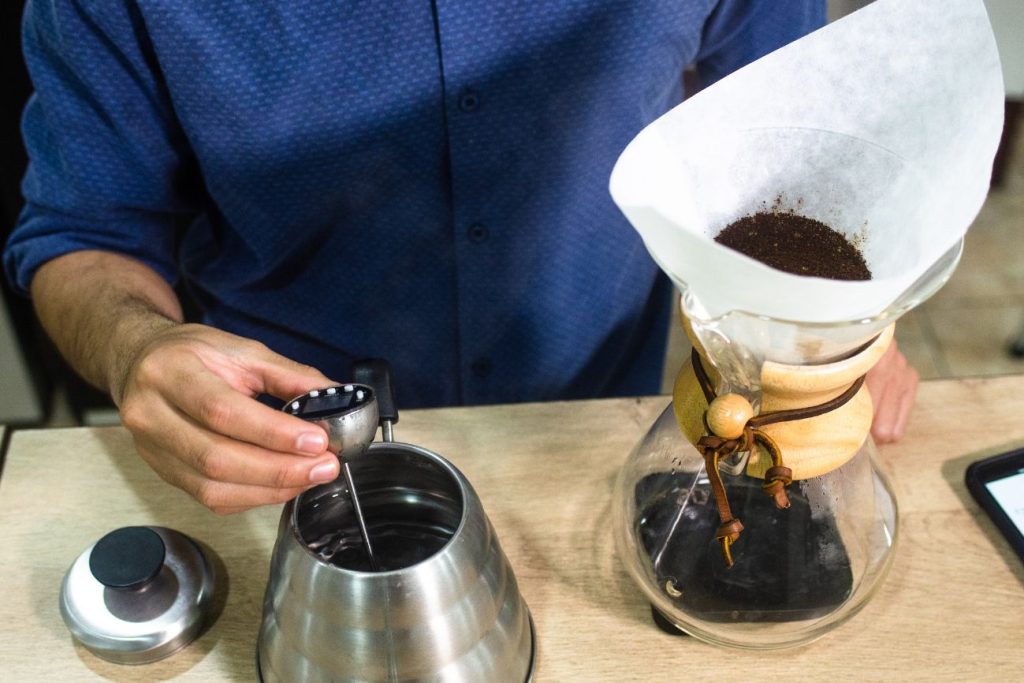
Step 1: Heat the Water
Begin by boiling your water. You’ll need enough hot water for brewing and a bit extra for rinsing the filter. Measure out the water if you’re using a scale – for example, to brew one full 16-ounce (475 ml) mug, you might use around 30 grams of coffee and 480 grams of water (a 1:16 coffee-to-water ratio)
Heat the water to about 200°F (93°C), which is just below a boil. If you don’t have a thermometer, bring the water to a boil and let it sit off the heat for ~30 seconds. (Using water in the range of 195–205°F is ideal for proper extraction
Step 2: Prepare the Chemex Coffee Maker and Filter
- Fold a Chemex paper filter into a cone (if it isn’t pre-folded) and place it in the Chemex with the triple-layered side toward the spout. This thick side against the spout creates an air channel so the brewed coffee can drip through without the filter sealing off the airway
- Rinse the filter by pouring some hot water around the inside of the filter, fully wetting it. This rinse does two things: it warms up the Chemex vessel and removes any papery taste from the filter
- Once the filter is saturated, carefully pour out the rinse water (lift the filter slightly to dump the water without dumping the filter). Make sure the filter remains in place against the glass.
Step 3: Add Coffee Grounds
Grind your fresh coffee beans to a medium-coarse consistency, about the texture of coarse sand or kosher salt. Aim for the amount of coffee that matches your desired yield. A good starting ratio is 1 part coffee to 15–17 parts water by weight.
For example, if you want to brew ~2 cups (16 oz) of coffee, use about 30 g of coffee and 450–500 g of water. Adjust the amount for a larger Chemex – for a full 6-cup Chemex, you might use 50 g of coffee to 800 g of water, for instance. Place the Chemex coffee maker (with rinsed filter) on your scale, add the ground coffee into the filter, and give the Chemex a gentle shake to level out the coffee bed. Tare (zero) the scale.
Step 4: Bloom the Coffee
- Start your timer as you begin this step. Pour a small amount of hot water over the grounds – just enough to wet all the coffee (you typically use about 2x the weight of the coffee; e.g. ~60 g of water for 30 g coffee).
- Pour slowly in a spiral or circle motion, ensuring all the grounds get wet. You should see the coffee “bloom”, which means it will puff up and bubble as CO₂ gas is released. This blooming stage is crucial because it allows trapped gases to escape and preps the grounds for optimal extraction
- Let the coffee bloom for about 30 to 45 seconds. (Freshly roasted coffee will have a vigorous bloom with lots of bubbling; older coffee may hardly bloom at all – a sign that it’s past peak freshness.)
Step 5: Continue Pouring (Main Brew)
After the bloom, continue pouring the hot water in stages. Aim to pour slowly and steadily in a spiral motion, starting from the center of the coffee bed and moving outward, then back toward the center. Avoid pouring directly on the paper filter or onto the sides of the Chemex, as that can cause water to bypass the coffee (leading to weaker extraction)
- Pour slowly in circular motions, starting from the center and moving outward.
- Divide the pour into 3-4 stages, ensuring all coffee grounds are saturated evenly.
- Total pouring time (including the bloom) should be around 3 to 4 minutes to get the best extraction.
Toward the end of the pouring, you can give the Chemex coffee maker a gentle swirl or use a spoon to give one light stir, which helps ensure all grounds are saturated and prevents any grounds from sticking to the sides.
Step 6: Let the Coffee Drain
- Once you’ve poured the desired amount of water, simply wait and let the coffee drip through the filter into the Chemex carafe. The last bit of water will filter through and the drip will slow to a stop.
- The total brew time (from the start of pouring to final drip) should be roughly 4 to 5 minutes for most brews. If it finishes much faster, your grind might be too coarse (resulting in under-extraction); if it takes significantly longer (7+ minutes), the grind might be too fine or the filter could be clogged (potentially causing over-extraction). The coffee bed at the end should be flat or slightly domed, not sludgy or with lots of dry pockets.
Step 7: Serve and Enjoy
Carefully remove the used filter with the spent grounds and discard it. Give the Chemex a gentle swirl to mix the coffee, then pour your freshly brewed coffee into cups. Take a moment to appreciate the aroma – Chemex coffee often has an incredibly clean fragrance.
Now sip and enjoy your brew! You should taste a clean cup with bright, nuanced flavors, one of the hallmarks of Chemex brewing. If it’s your first time, note down how it tastes; you can always adjust the variables next time to better suit your taste (strength, flavor balance, etc.).
That’s it – you’ve brewed coffee with a Chemex! It might take a couple of tries to get perfectly comfortable with the pouring technique and timing, but even your first brew should be quite enjoyable. Next, we’ll cover some tips to help you refine your process and get the absolute best flavor.
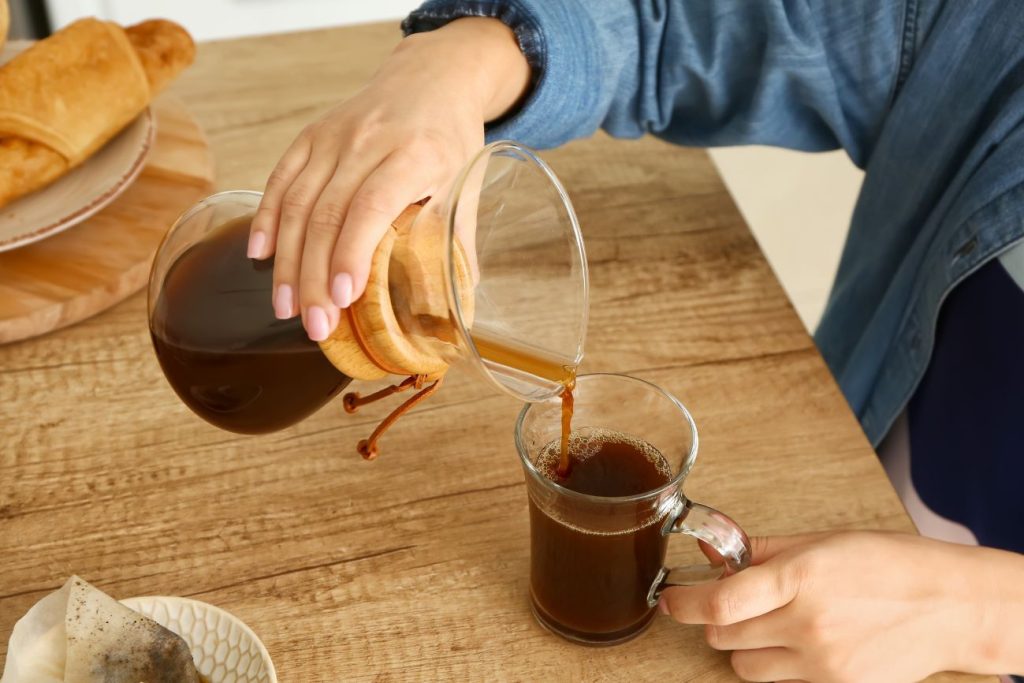
Chemex Brewing Troubleshooting
Brewing with Chemex coffee maker is simple, but sometimes issues arise. Below are common problems and solutions.
1. Coffee Tastes Bitter or Over-extracted
Possible Causes:
- Grind Too Fine: Fine grind slows water flow, causing over-extraction.
- Water Temperature Too High: Water above 200°F can over-extract and cause bitterness.
- Brew Time Too Long: Long brew time extracts too much, leading to bitterness.
Solution:
- Grind Size: Use a medium-coarse grind for proper water flow.
- Water Temperature: Maintain water at 200°F (93°C) for optimal extraction.
- Brewing Time: Brew for around 4-5 minutes to avoid over-extraction.
2. Coffee Tastes Weak or Under-extracted
Possible Causes:
- Grind Too Coarse: Coarse grind causes water to flow too fast, leading to under-extraction.
- Too Little Coffee: Not enough coffee for the amount of water creates a weak brew.
Solution:
- Grind Size: Use a slightly finer grind for balanced extraction.
- Coffee-to-Water Ratio: Use a 1:15 ratio (coffee to water) for consistency.
3. Water Flow Is Too Slow or Too Fast
Possible Causes:
- Improper Pouring: Pouring too quickly or unevenly affects water flow.
- Clogged Filter: A thick filter or improper folding can restrict water flow.
Solution:
- Pouring Technique: Pour slowly in circular motions, ensuring even saturation of coffee grounds.
- Filter Positioning: Fold filters properly, ensuring the thicker side faces the spout.
4. Coffee Tastes Sour or Underdeveloped
Possible Causes:
- Grind Too Coarse: Coarse grounds under-extract, leading to sour flavors.
- Water Flow Too Fast: Fast water flow causes under-extraction, resulting in sourness.
Solution:
- Grind Size: Opt for a medium-coarse grind for optimal extraction.
- Pouring Technique: Pour water evenly and slowly, allowing grounds to bloom before continuing.
5. Filter Collapse or Overflow
Possible Causes:
- Too Much Coffee: Overfilling the filter can cause overflow.
- Incorrect Filter Fold: Improperly folded filters lead to collapse and poor drainage.
Solution:
- Amount of Coffee: Use the correct coffee amount for your Chemex size.
- Proper Filter Folding: Fold filters correctly with the thicker side facing the spout.
6. Uneven Coffee Grounds Distribution
Possible Causes:
- Uneven Grounds: Uneven distribution of grounds leads to uneven extraction.
Solution:
- Even Distribution: Gently tap Chemex coffee maker after adding grounds to level them.
7. Water Isn’t Fully Draining Through
Possible Causes:
- Clogged Filter: Too many grounds or thick filter can block water flow.
- Improper Filter Position: If not seated properly, the filter may prevent water drainage.
Solution:
- Filter Check: Ensure the filter is seated correctly with the thicker side facing the spout.
- Even Coffee Grounds: Spread coffee evenly for optimal water flow.
8. Grains or Sediment in the Coffee
Possible Causes:
- Inadequate Filter: Fine particles might slip through a low-quality filter.
- Grind Too Fine: A fine grind can let more particles through the filter.
Solution:
- Fresh Filters: Always use a fresh, properly fitted Chemex filter.
- Grind Size: Use a medium-coarse grind to reduce sediment.
By following these troubleshooting tips, you’ll get the best out of your Chemex coffee each time.
If your coffee doesn’t taste perfect, here are some troubleshooting tips:
| Problem | Possible Cause | Solution |
| Coffee tastes bitter | Grind is too fine, over-extraction | Adjust grind size and pour slower |
| Coffee is weak | Grind is too coarse, under-extraction | Use a finer grind and adjust pour timing |
| Coffee tastes flat | Uneven saturation during blooming | Stir after blooming to ensure even extraction |
Pro Tips for the Perfect Chemex Coffee
Achieving a perfect cup of Chemex coffee requires precision and a bit of finesse. Here are some professional tips to elevate your brew:
1. Use Fresh Coffee Beans
Always use freshly roasted coffee beans for the best flavor. Beans should be ground just before brewing.
2. Choose the Right Grind Size
Opt for a medium-coarse grind, similar to sea salt. This helps with even extraction.
3. Measure Your Coffee and Water
Use a digital scale to measure the coffee and water ratio. A 1:15 ratio is ideal.
4. Pre-wet Your Filter
Rinse your Chemex filter with hot water before brewing. This removes paper taste and helps preheat the brewer.
5. Use Filtered Water
Always use filtered water to avoid off-flavors that tap water might introduce to your coffee.
6. Optimal Water Temperature
Heat water to 200°F (93°C), just below boiling. This is the ideal temperature for coffee extraction.
7. Pour in Stages
Pour in a slow, circular motion. Start with a bloom pour, wait 30 seconds, then pour in stages.
8. Don’t Overfill the Filter
Avoid overfilling your Chemex, as this can cause overflow. Stick to your Chemex’s recommended cup size.
9. Keep Your Equipment Clean
Regularly clean your Chemex coffee maker and all brewing accessories to prevent old coffee oils from affecting flavor.
10. Experiment with Brew Time
If your coffee tastes too weak or strong, adjust your brew time. Aim for 4-5 minutes.
By following these pro tips, you’ll be able to brew a perfect cup of Chemex coffee every time!
What Makes the Chemex Coffe Maker a Great Choice?
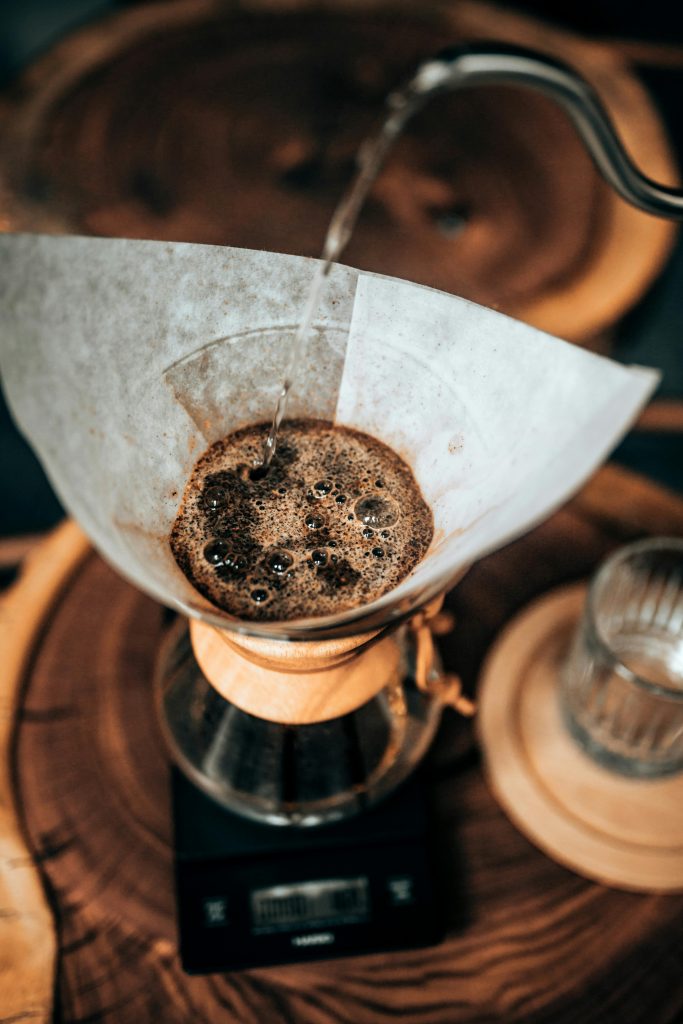
If you’ve ever admired a sleek glass coffeemaker with a wooden collar sitting on someone’s kitchen counter, chances are you were looking at a Chemex. Beyond its eye-catching design, the Chemex is beloved by coffee enthusiasts for several compelling reasons:
1. Impressively Clean, Bright Flavor
- Thick Filter Design: Chemex filters are thicker than standard coffee filters. This helps remove more oils and fine particles, resulting in a clear, crisp cup that highlights subtle flavor notes.
- Enhanced Nuances: Thanks to the paper’s density, flavors that might be muddied in other brewing methods come through with more brightness. If you enjoy light to medium roasts, the Chemex’s clean extraction makes every sip a delight.
2. Elegant & Functional Design
- Iconic Look: Invented in 1941 by Dr. Peter Schlumbohm, the Chemex’s hourglass shape and wooden collar have made it a design icon—so much so that it’s featured in modern art museums.
- One-Piece Vessel: The borosilicate glass flask is both heat-resistant and easy to clean. The wooden collar (or glass handle, if you choose that version) makes it comfortable to pour without burning your hands.
3. Full Control Over Brewing
- Customizable Variables: The Chemex is a pour-over method, giving you direct control over water temperature, pour speed, bloom time, and coffee-to-water ratio. This level of control empowers you to truly dial in your ideal cup.
- Simple, Hands-On Process: There’s something rewarding about manually pouring water over fresh grounds. Many coffee lovers find the Chemex brewing ritual mindful and satisfying.
4. Great for Showcasing Single-Origin Coffees
- Flavor Clarity: If you’re exploring single-origin beans—like fruity Ethiopian coffees or chocolaty Guatemalan varieties—the Chemex is one of the best ways to highlight these nuanced flavors. It’s a popular choice among specialty coffee enthusiasts for precisely this reason.
5. Easy Cleanup and Maintenance
- Quick Rinse: After brewing, just toss the used filter and rinse the carafe. The wide opening and durable glass make it simple to keep your Chemex clean and odor-free.
- Durable Materials: With proper care, a Chemex can last for years. Just be sure to remove the wood collar periodically for a thorough cleaning and handle the glass gently.
6. Aesthetically Pleasing Experience
- Visual Appeal: Watching coffee bloom and drip through the thick filter into the glass chamber is a joy—part science, part art.
- Social Coffee Ritual: The Chemex adds a touch of ceremony and style when brewing for friends or guests. It’s a conversation starter, thanks to its timeless look.
Useful Chemex Accessories for Travel
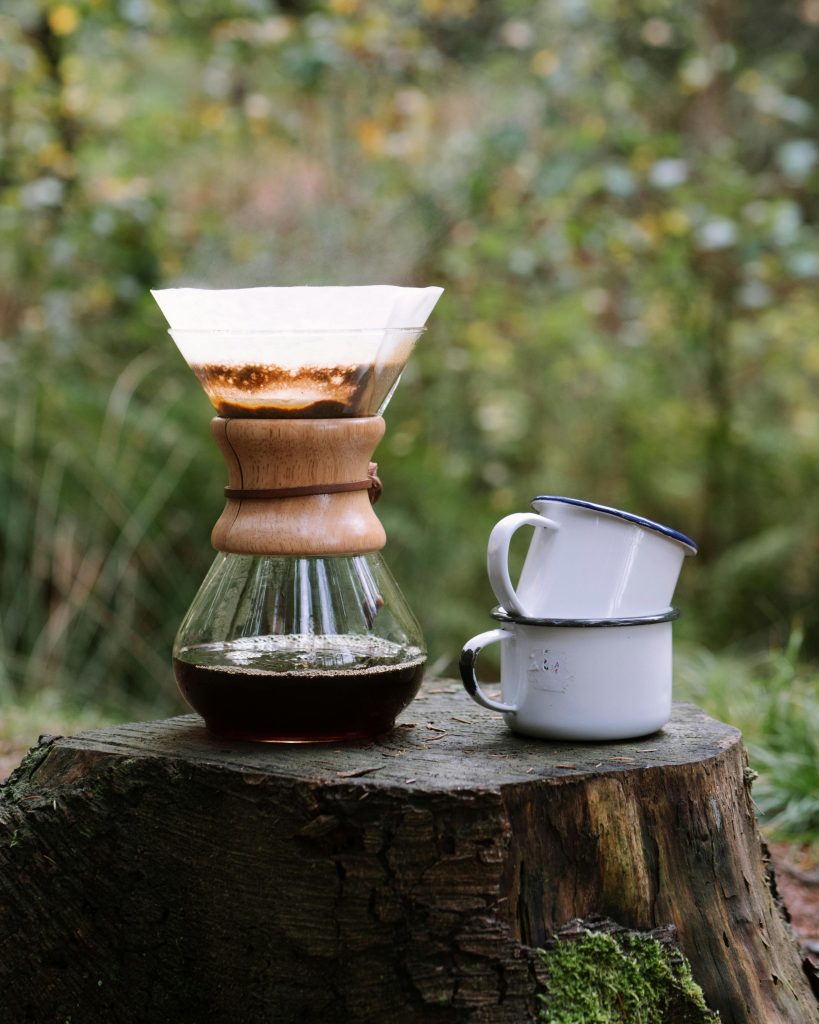
While Chemex coffee maker is primarily used for brewing at home, there are useful accessories that can help you brew on-the-go, especially if you’re a coffee traveler.
| Accessory | Why You Need It |
| Portable Coffee Grinder | Essential for freshly grinding beans wherever you are |
| Thermal Flask or Insulated Carafe | Keeps your coffee hot while traveling |
| Portable Chemex Set | Small, travel-sized versions of Chemex for brewing on the go |
| Coffee Dripper Travel Case | Protects your Chemex and accessories during travel |
Chemex Travel Tips
If you love brewing coffee on the go, here are a few travel tips to make it easier:
- Grind your beans at home before your trip and carry them in an airtight container to maintain freshness.
- Bring a small portable kettle that allows for precise temperature control even when traveling.
- If you’re camping or away from home, consider using a travel-sized Chemex coffe maker (available in smaller sizes like 3 cups) that fits easily in a bag or travel kit.
FAQs About Brewing Coffee with Chemex Coffee Maker
Final Thoughts
Brewing coffee with a Chemex coffee maker is a delightful experience that combines craft and taste. You’ve learned about the Chemex’s rich history and intelligent design, gathered your equipment, and followed the steps to make a delicious brew. With the provided tips, you can refine your technique – dialing in the grind, perfecting your pour, and choosing beans that sing in your cup. We’ve also covered what not to do and how to solve common brewing issues, so you’re well-equipped to handle any challenges.
Keep in mind that every variable – from the coffee beans and roast level to the grind, water, and pouring style – can affect the final cup. Part of the fun is experimenting with these variables. Try a new origin coffee, tweak your ratio, or adjust your pour rhythm, and take note of how it changes the flavor. The Chemex is forgiving and versatile, so feel free to explore.
Most importantly, enjoy the process. The few minutes spent patiently pouring and watching coffee drip into the beautiful Chemex carafe can be a calming ritual to start your day. And the reward is a bright, clean, and flavorful cup of coffee that you crafted by hand. As the makers of Chemex like to remind us, it was invented to make brewing easy and enjoyable – with a little practice you’ll master it, and it might even become the favorite part of your morning routine.
So grab your Chemex, heat that kettle, and have fun brewing. Cheers to many excellent coffee moments ahead!

